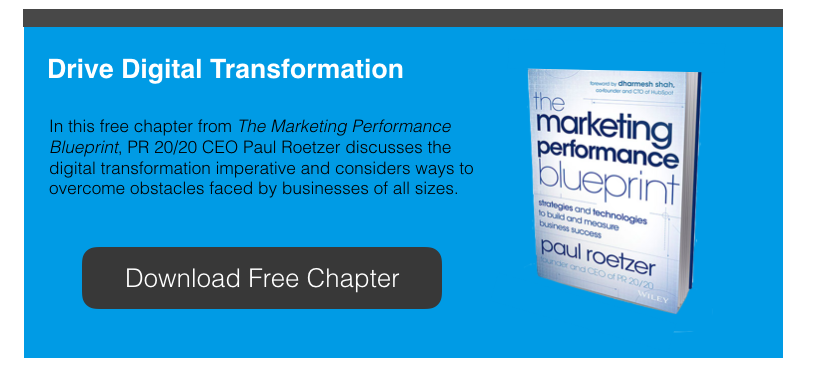Editor's note: The following is an excerpt from The Marketing Performance Blueprint, and was also published on the HubSpot Agency Post.
 The marketing services industry is in a state of flux. As CMOs navigate the marketing talent gap, they are increasingly seeking performance-driven agency partners that are immersed in marketing technology and staffed with digital-savvy professionals. SMBs need partners that can deliver fully integrated solutions and in essence function as outsourced inbound marketing teams. Large enterprises commonly look for niche expertise in core digital disciplines such as content marketing, paid search, SEO, social media monitoring, and analytics to complement internal marketing teams.
The marketing services industry is in a state of flux. As CMOs navigate the marketing talent gap, they are increasingly seeking performance-driven agency partners that are immersed in marketing technology and staffed with digital-savvy professionals. SMBs need partners that can deliver fully integrated solutions and in essence function as outsourced inbound marketing teams. Large enterprises commonly look for niche expertise in core digital disciplines such as content marketing, paid search, SEO, social media monitoring, and analytics to complement internal marketing teams.
The future belongs to dynamic agencies with more efficient management systems, integrated services, versatile talent, value-based pricing models, a love for data, and a commitment to producing measurable results. These tech savvy modern marketing firms thrive on change and continually apply advances in technology to strengthen their businesses, adapt their services, and deliver greater value to you, the client.
As I wrote in my first book, The Marketing Agency Blueprint, “We are on the cusp of a truly transformational period in the marketing services industry. The old guard, rooted in tradition and resistant to change, will fall and new leaders will emerge. The industry will be redefined by marketing agencies that are more nimble, tech savvy, open, and collaborative. Digital services will be ingrained into the DNA of every agency, and blended with traditional methods to execute integrated campaigns… . Their value and success will be measured by outcomes, not outputs.”
However, these digital-savvy firms are in short supply. Online education and certification initiatives are building a more advanced ecosystem of marketing service providers. But for the time being, the agency landscape remains littered with traditional agencies struggling to transform their archaic business models. The traditionalists that are unable or unwilling to evolve will eventually fade, and the new category of disruptive agencies will rise to prominence.
But this disrupting class will take time to mature and will struggle to scale growth and meet demand in the short term.
Finding Your Match
Despite the challenges of finding digital-savvy agency partners, marketers are outsourcing at record rates. According to Accenture’s “Turbulence for the CMO” report, CMOs are turning to a large mix of agency partners and marketing service providers, outsourcing “between 45 percent and 75 percent of marketing activities.”
Paid search (41 percent), search engine optimization (39 percent), social media monitoring (37 percent), email marketing (33 percent), web analytics (32 percent), marketing analytics (30 percent), and marketing automation (28 percent) are among the digital activities being farmed out to integrated agencies and specialty shops. The Accenture study, which surveyed 405 senior executives, mostly with at least $1 billion in annual revenue, reports that “CMOs are generally more satisfied with marketing areas managed by external resources than with their own people.”
However, other studies, including “More Strain, Less Gain” from the CMO Council and Ace Metrix, report that marketers still face an uphill battle in connecting agency activities to performance metrics. In the press release introducing the 2012 report, Donovan Neale-May, CMO Council executive director, states, “There’s an underlying level of frustration among senior corporate marketers worldwide when it comes to agency contributions to business value creation, strategic thinking, and digital marketing development.”
The right marketing agency can be a tremendous asset to your organization and play a critical role in propelling growth, but marketers must take a methodical approach to finding the right firms. Here are seven rules to keep in mind when evaluating and selecting agency partners.
1) Partner with Performance-Driven Firms
Marketers are being held to higher ROI standards, and the same needs to be true of agency partners. Historically, marketing agencies have gotten away with reporting relatively meaningless metrics such as impressions, advertising equivalency, and PR value, or relying strictly on qualitative results. Leading marketing agencies build campaigns that consistently produce measurable outcomes, including website traffic, subscribers, leads, and sales. Work with agency partners that care as much about performance and success as you do.
2) Assess the Account Team
The greatest value an agency can bring a client is staffing its account team with A players. Look for firms that have a history of recruiting and retaining top talent. Understand how your account team will be structured, including who is responsible for planning, production, account management, and day-to-day client communications. Also consider if the firm you hire is outsourcing any services to freelancers or partner agencies. This is a common practice, but it is important that you are aware of and have confidence in any third parties that will be working on your account.
3) Find Tech-Savvy Firms
Agencies whose professionals are immersed in technology trends and innovations are able to more readily adapt their own business models, continually increase productivity, evolve client campaigns, and make strategic connections to seemingly unrelated information.
Find out what marketing technologies the agency uses to run its own business, how it integrates technology into client campaigns, and how it ensures that its staff remains current on technology news and trends.
4) Demand That Digital Is Ingrained in Their DNA
Every agency that will be relevant in the future is a digital agency. Having a digital division or group within a traditional agency is not sufficient. Digital has to be ingrained into the agency’s culture and talent.
Agencies structured in service-area silos -- social, search, mobile, web, email, analytics -- will face the same challenges as their corporate counterparts when trying to build digital marketing strategies and campaigns. Digital must be fully integrated, along with traditional activities, into every program and budget.
5) Invest in the Doers
The marketing services world is full of thinkers, talkers, and self-proclaimed gurus. Turn to agencies with demonstrated track records of success, starting with their own brands. Evaluate the strength of their website, the power of their staff’s personal brands, the value and frequency of content on their blog, and their reach and engagement in social networks.
6) Seek Systems for Success
Prototype agencies are powered by systems that continually increase efficiencies and productivity, encourage creativity and innovation, and push professionals to realize and embrace their potential. All of this produces higher performance levels and more satisfied clients.
Align your organization with agencies that take a systemic approach to professional development, project management, client services, monitoring, measurement, reporting, and communications. These firms:
- Keep projects on time and in budget.
- Maintain high levels of attention to detail and quality.
- Set realistic expectations and goals, which align with client resources and potential.
- Communicate project statuses, campaign successes and setbacks, shifts in priorities, real-time opportunities, and more.
- Produce measurable results.
7) Find Partners, Not Providers
Marketing agencies often look and sound the same. They offer similar services, tout impressive client lists, and flaunt industry awards lauding their creativity. But none of that really matters to your business. When selecting an agency partner, it is essential to move beyond the standard stuff and find partners who think and act differently and take a customized approach to your business.
When all else is equal, it is an agency’s culture and talent that determine its ability to positively impact your business. We have found that the most successful marketing programs are those built on strong client-agency partnerships with a foundation of trust, respect, and aligned expectations and goals. These are the relationships in which the client looks to the agency as an extension of its marketing team, not as just another vendor.
Your agency team has to become indispensible through their hard work, insight, consultation, services, expertise, friendship, and professionalism. They must do the little things that build relationships and take the time to show you they care about your successes, both on individual and organizational levels.
Managing the Outsourced Teams
Unfortunately, no matter how thorough the agency search, client-agency partnerships do not always go as planned. While both parties enter the relationship with the best of intentions, challenges arise and partnerships dissolve. However, many factors that contribute to relationships going bad can either be avoided or overcome, if you know the causes.
Let’s take a look at agency-side and client-side factors that can lead to unproductive partnerships and the inevitable breakups.
Agency-Side Factors
Common reasons the agency may be to blame:
Financial Instability
Desperation is a very dangerous thing in business. Agencies in difficult financial positions may be forced to cut corners on staffing, take on bad accounts that distract from the good ones, and make decisions that are not in the long-term best interest of the agency or its clients. If you get the sense an agency is struggling financially, run the other way.Along those lines, ask the difficult financial questions up front to avoid problems later. Ensure that potential partners have strong cash flow, profits, and/or funding, especially when working with startup marketing firms.
Focusing on Outputs, not Outcomes
Rely on agency partners that continually adapt strategies based on performance, obsess over data, and are driven to exceed ROI expectations. Avoid agencies that focus primarily on deliverables and lack systems to show how those outputs affect marketing metrics that matter to the client. Agencies that still use the billable-hour model may be the biggest culprits in this arena, by putting the emphasis on time spent rather than value gained.
Overpromising, Underdelivering
Most relationships that go bad are doomed from the start. In many cases, it is because the agency overpromises what it can achieve for a client. Expectations get set too high, and when the agency does not deliver, the client is forced to move on.
Siloed Services
Siloed activities, within your organization or your agency, create a disconnected customer experience. Strategies cannot be built in isolation if marketers want to maximize ROI. There has to be an integrated approach to a cohesive marketing strategy. Even if your business has multiple outside agency partners, their activities still must be in sync and complementary.
Stagnant Business Model
According to the CMO Council, “Just 9 percent of senior marketers believe traditional ad agencies are doing a good job of evolving and extending their service capabilities in the digital age.”10 Creating compelling customer experiences, which are core to marketing success, requires a sophisticated, agile, integrated, and highly measurable approach to targeting consumers. If an agency is stuck in legacy systems and taking an obsolete approach to targeting audiences, then clients need a change of direction.
Being Stretched too Thin
Financial difficulties, mismanagement, and challenges scaling to meet market demand can all contribute to agencies being stretched too thin. In all cases, it is the client that suffers. Traditional agencies are primarily driven by service revenue, so the size and capacity of the staff directly affect profits. Too many professionals, and profits quickly shrink or disappear. Too few professionals, and there is more work than they can handle. Being stretched too thin over extended periods of time negatively impacts morale, culture, productivity, and performance, which can cause clients to leave.
Talent Turnover
As discussed in the previous section, the greatest value an agency can give you is stocking your account team with top-notch, digital-savvy professionals. If the agency struggles to retain its best talent, then clients have no reason to stay.
Unbalanced Portfolio
At PR 20/20, we follow the model that no client should account for more than 20% of revenue. Agencies that are too heavily reliant on a select few accounts put themselves and their other clients at risk if that revenue is lost. There also is the possibility that an agency will put a disproportionate amount of energy, talent, and resources into the largest accounts, which can limit the value delivered to smaller clients. It is in the best interest of agencies and clients for the agency to have a well-balanced portfolio.
Weak Processes
Weak or no processes lead to inefficiency and lack of productivity, both of which cost you time, money, and results. Insist on a sophisticated approach to business, account, and campaign management.
Client-Side Factors
Common reasons the client may be to blame:
Conservative Culture and Budgets
Great marketing agency partners can be made mediocre by conservative client cultures and budgets. If the client is not willing to adapt to changing consumer behavior and invest resources needed to improve short- and long-term performance, then both parties will end up unhappy in the relationship. Our Marketing Score research shows that the majority of organizations have aggressive growth goals and conservative budgets, creating a potential misalignment of expectations. Fortyone percent of organizations have aggressive growth goals (greater than 20 percent), but only 5 percent of organizations have aggressive marketing budgets (greater than 20 percent).
Financial Instability
There is nothing more debilitating to a partnership than a financially unstable client (besides maybe a financially desperate agency). Clients in dire financial straits constantly shift expectations and priorities, lose patience with proven long-term processes, and demand more for less. Financial instability should be the number one red flag for agencies when evaluating clients.
Lack of Vision
Much like a conservative culture, a lack of vision within the client business is a nearly impassable roadblock for agencies. An agency cannot make your business or brand remarkable. Vision means that your leadership team sees opportunities where others see obstacles. An elite agency partner can play an integral role in building and realizing the vision, but it must be born from and cultivated by the client’s leaders.
Low-Quality Product/Service
Customer experience is everything in the era of the exposed brand, and nothing will derail marketing success faster than a subpar product or service. Hiring a top-tier marketing agency will not mask or solve deficiencies in this area. Agencies should partner with companies and products they believe in. Agency account teams will struggle to maintain the necessary energy and passion when they know a client’s product is low quality. Marketing technology deficiencies: Modern marketing success requires the right tools and infrastructure, including analytics, a sophisticated CRM system, email marketing, marketing automation, and a website CMS. If a client is not willing to invest in core marketing technologies and commit to integrating them into sales and marketing processes, then agencies will fail.
Personnel Weaknesses
Marketing and sales team weaknesses can be a major influencing factor on underperforming agencies, especially if the client is not willing to invest the resources needed to fill internal gaps or make difficult changes to processes and culture. Let’s say, for example, that an agency is brought in primarily to build brand -- website traffic, social reach, subscribers -- at the top of the funnel and generate leads in the middle of the funnel. Leads are qualified through an automated lead scoring system and handed off to internal marketing and sales teams to convert. If the internal teams drop the ball through lack of effort or underperformance and continually fail to convert quality leads, bottom-line sales will give the appearance that the agency is not providing a positive ROI. Clients have to be realistic about their internal teams’ capabilities, and agencies have to be able to gauge how their success will be helped or hindered by client-side personnel.
Poor Management
Weak management and leadership within the client organization commonly lead to many of the other negative factors, including financial instability, lack of vision, conservative cultures, and personnel weaknesses. There is nothing an agency can do to fix any of these.
Unrealistic Expectations
Setting realistic expectations may be the most important step in building a successful partnership. Clients have to take an honest look at their strengths and weaknesses, and agencies have to be able to assess potential and forecast success.
Weak Foundation
Business and marketing core strength is critical to success. Specifically, this includes factors such as competitive advantage, corporate culture, employee retention rates, financial stability, the marketing team, pricing strategy, product/service quality, proprietary audience database size, revenue growth, social reach, and website traffic. All these factors are indicators of a client’s potential and an agency’s ability to accelerate success and meet ROI expectations.
The marketing industry is moving too fast to internalize everything. Businesses increasingly rely on marketing agency partners for consultation and services to differentiate their brands and drive growth and success. You can gain an advantage over the competition by taking an intelligent approach to selecting and managing your agencies.

%20Logo_BlueOrange_Trademark.png?width=800&height=269&name=Ready%20North%20(RN)%20Logo_BlueOrange_Trademark.png)




.jpg?width=300&name=Services%20Hub%203%20(3).jpg)



COMMENTS